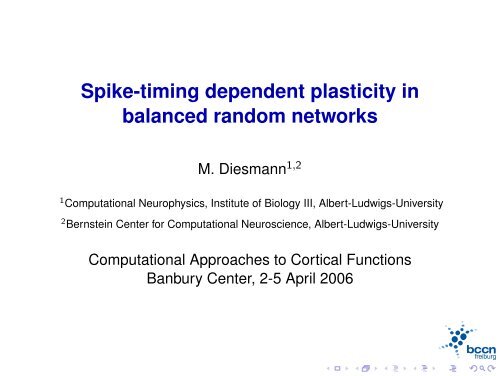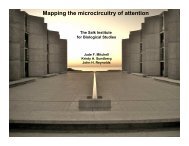Spike-timing dependent plasticity in balanced random networks
Spike-timing dependent plasticity in balanced random networks
Spike-timing dependent plasticity in balanced random networks
You also want an ePaper? Increase the reach of your titles
YUMPU automatically turns print PDFs into web optimized ePapers that Google loves.
<strong>Spike</strong>-<strong>tim<strong>in</strong>g</strong> <strong>dependent</strong> <strong>plasticity</strong> <strong>in</strong><br />
<strong>balanced</strong> <strong>random</strong> <strong>networks</strong><br />
M. Diesmann 1,2<br />
1 Computational Neurophysics, Institute of Biology III, Albert-Ludwigs-University<br />
2 Bernste<strong>in</strong> Center for Computational Neuroscience, Albert-Ludwigs-University<br />
Computational Approaches to Cortical Functions<br />
Banbury Center, 2-5 April 2006<br />
freiburg
Thanks<br />
◮ Abigail Morrison<br />
◮ Ad Aertsen<br />
◮ Guo-qiang Bi<br />
(for provid<strong>in</strong>g orig<strong>in</strong>al data)<br />
◮ NEST Initiative<br />
A. Morrison, A. Aertsen, & M. Diesmann (2005)<br />
<strong>Spike</strong>-<strong>tim<strong>in</strong>g</strong> <strong>dependent</strong> <strong>plasticity</strong> <strong>in</strong> <strong>balanced</strong> <strong>random</strong> <strong>networks</strong><br />
Neural Computation, under review<br />
freiburg
Consistency of cortical network model<br />
model<br />
data<br />
ν ext<br />
J<br />
E<br />
J<br />
X<br />
ν ext<br />
J<br />
J<br />
I<br />
−gJ<br />
−gJ<br />
(Brunel, 2000)<br />
(Bi & Poo, 1998)<br />
Is the network model compatible with the data?<br />
freiburg
Outl<strong>in</strong>e<br />
Choice of STDP model<br />
Plastic Networks<br />
Development of structure<br />
Robustness<br />
Synchronous stimulation<br />
freiburg
Outl<strong>in</strong>e<br />
Choice of STDP model<br />
Plastic Networks<br />
Development of structure<br />
Robustness<br />
Synchronous stimulation<br />
freiburg
Outl<strong>in</strong>e<br />
Choice of STDP model<br />
Plastic Networks<br />
Development of structure<br />
Robustness<br />
Synchronous stimulation<br />
freiburg
Outl<strong>in</strong>e<br />
Choice of STDP model<br />
Plastic Networks<br />
Development of structure<br />
Robustness<br />
Synchronous stimulation<br />
freiburg
Outl<strong>in</strong>e<br />
Choice of STDP model<br />
Plastic Networks<br />
Development of structure<br />
Robustness<br />
Synchronous stimulation<br />
freiburg
Choice of STDP model<br />
◮ Additive, multiplicative, . . . ?<br />
◮ All to all, nearest neighbor, . . . ?<br />
Can the existent experimental data help to reduce the plethora<br />
of possible models?<br />
freiburg
Back to the orig<strong>in</strong>al data<br />
(Bi & Poo, 1998)<br />
What, if anyth<strong>in</strong>g, does this tell us about the weight<br />
dependency of the STDP update?<br />
freiburg
Weight dependency of STDP<br />
A<br />
PSC change [pA]<br />
300<br />
100<br />
30<br />
10<br />
3<br />
0<br />
−3<br />
−10<br />
−30<br />
−100<br />
−300<br />
30 100 300 1000 3000<br />
Initial PSC [pA]<br />
B<br />
PSC change [%]<br />
100<br />
◮ pale gray additive<br />
◮ dark gray multiplicative<br />
50<br />
◮ power law with µ = 0.4<br />
◮ depression multiplicative<br />
0<br />
−50<br />
−100 −50 0 50 100<br />
<strong>Spike</strong> <strong>tim<strong>in</strong>g</strong> [ms]<br />
freiburg
Weight dependency of STDP<br />
B<br />
PSC change [%]<br />
100<br />
50<br />
0<br />
◮ darker for higher <strong>in</strong>itial w<br />
◮ variability may result from<br />
different <strong>in</strong>itial w<br />
◮ depression multiplicative<br />
→ no dependence on w<br />
−50<br />
000 −100 −50 0 50 100<br />
<strong>Spike</strong> <strong>tim<strong>in</strong>g</strong> [ms]<br />
freiburg
Weight dependency of STDP<br />
change <strong>in</strong> PSC amplitude<br />
1<br />
0.8<br />
0.6<br />
0.4<br />
0.2<br />
0<br />
0 20 40 60 80 100<br />
<strong>in</strong>itial PSC amplitude [pA]<br />
additive (Song, Miller, & Abbott)<br />
multiplicative (Rub<strong>in</strong>, Lee, & Sompol<strong>in</strong>sky)<br />
<strong>in</strong> between (Gütig, Aharonov et al.)<br />
∆w − (w, t) = −λαw µ K (t, θ post)<br />
∆w + (w, t) = λ (1 − w) µ K (t, θ pre)<br />
∑<br />
−(T −tx)/τ<br />
K (T, θ x) =<br />
e<br />
power law<br />
t x∈θ x:t x
<strong>Spike</strong> pair<strong>in</strong>g scheme<br />
A<br />
48<br />
nearest neighbor<br />
A<br />
48<br />
B<br />
45.6<br />
B<br />
45.6<br />
all to all<br />
weight [pA]<br />
47<br />
46<br />
45<br />
44<br />
weight [pA]<br />
47<br />
45.55 45.55<br />
46<br />
45.5 45.5<br />
45<br />
45.45 45.45<br />
44<br />
45.4 45.4<br />
0 100 0 100 200 300 200 300 0 1000 200 100 300 200 300<br />
time [s] time [s]<br />
time [s] time [s]<br />
◮ self-consistent rate necessary for stability<br />
◮ nearest neighbor scheme amplifies rate disparity<br />
◮ all to all spike scheme counteracts rate disparity<br />
freiburg
Weight distribution <strong>in</strong> a fully plastic network<br />
A<br />
area diff. [%]<br />
1<br />
0.8<br />
0.6<br />
0.4<br />
0.2<br />
B<br />
frac. synapses<br />
0.1<br />
0.05<br />
C<br />
C(τ)<br />
0<br />
0 500 1000 1500 2000<br />
time [s]<br />
4<br />
2<br />
0<br />
−2<br />
6 x 10−4<br />
−75 −50 −25 0 25 50 75<br />
D<br />
0<br />
4<br />
2<br />
0<br />
−2<br />
6 x 10−4<br />
35 45 55<br />
weight [pA]<br />
Given a desired w ∗ of a static BRN, α p can be calculated.<br />
◮ α = 1.057α p to compensates for correlation<br />
◮ weight distribution settles to Gaussian with<strong>in</strong> 200 s<br />
−75 −50 −25 0 25 50 75<br />
freiburg
a<br />
0.2<br />
fr<br />
Activity <strong>in</strong> a fully plastic network<br />
0<br />
0 500 1000 1500 2000<br />
time [s]<br />
0<br />
35 45 55<br />
weight [pA]<br />
C<br />
6 x 10−4 τ [ms]<br />
4<br />
D<br />
6 x 10−4 τ [ms]<br />
4<br />
C(τ)<br />
2<br />
2<br />
0<br />
0<br />
−2<br />
−2<br />
−75 −50 −25 0 25 50 75<br />
−75 −50 −25 0 25 50 75<br />
◮ AI dynamics<br />
◮ rate slightly higher (8.8 Hz) than <strong>in</strong> static network (7.7 Hz)<br />
◮ similar Fano factor and coefficient of variation<br />
freiburg
Individual weight trajectories<br />
56<br />
54<br />
52<br />
50<br />
weight [pA]<br />
48<br />
46<br />
44<br />
42<br />
40<br />
38<br />
0 100 200 300 400 500<br />
time [s]<br />
◮ weight distribution settles fairly quickly ...<br />
◮ ... but <strong>in</strong>dividual weight trajectories rema<strong>in</strong> dynamic<br />
◮ neither spontaneous development of structure nor<br />
wither<strong>in</strong>g<br />
freiburg
Survival time of strong synapses<br />
10 6 survival time [s]<br />
10 5<br />
10 4<br />
synapses<br />
10 3<br />
10 2<br />
10 1<br />
10 0<br />
0 200 400 600 800 1000<br />
◮ exponential decay with τ ≈ 55s of top 10%<br />
◮ time shift <strong>in</strong>variant statistics, steps of 200s shown<br />
◮ no development of structure<br />
freiburg
Sensitivity to scal<strong>in</strong>g of depression<br />
C(τ)<br />
5<br />
4<br />
3<br />
2<br />
1<br />
0<br />
−1<br />
x 10 −4<br />
3<br />
0<br />
−3<br />
−50 0 50<br />
◮ at higher α (stronger<br />
depression), here 2%, a<br />
new stable state emerges<br />
at a lower rate<br />
◮ but, if α chosen 2% too<br />
low, the network explodes<br />
6 x 10−4 τ [ms]<br />
−2<br />
−75 −50 −25 0 25 50 75<br />
◮ new regime displays<br />
strongly patterned activity<br />
<strong>in</strong>terspersed with silence<br />
freiburg
Sensitivity to scal<strong>in</strong>g of depression<br />
frac. synapses<br />
0.12<br />
0.1<br />
0.08<br />
0.06<br />
0.04<br />
0.02<br />
rate [Hz]<br />
200<br />
150<br />
100<br />
50<br />
0<br />
5 15 25<br />
time [s]<br />
◮ at higher α (stronger<br />
depression), here 2%, a<br />
new stable state emerges<br />
at a lower rate<br />
◮ but, if α chosen 2% too<br />
low, the network explodes<br />
0<br />
0 50 100 150 200 250 300<br />
weight [pA]<br />
◮ new regime displays<br />
strongly patterned activity<br />
<strong>in</strong>terspersed with silence<br />
freiburg
Sensitivity to scal<strong>in</strong>g of depression<br />
A<br />
rate [Hz]<br />
B<br />
rate [Hz]<br />
C<br />
3500<br />
3000<br />
2500<br />
2000<br />
1500<br />
1000<br />
500<br />
2000<br />
1500<br />
1000<br />
500<br />
0<br />
29 29.2 29.4 29.6 29.8 30<br />
time [s]<br />
0<br />
100<br />
D<br />
E<br />
◮ at higher α (stronger<br />
depression), here 2%, a<br />
new stable state emerges<br />
at a lower rate<br />
◮ but, if α chosen 2% too<br />
low, the network explodes<br />
◮ new regime displays<br />
strongly patterned activity<br />
<strong>in</strong>terspersed with silence<br />
neuron id<br />
75<br />
50<br />
25<br />
29.1 29.1025 29.105<br />
time [s]<br />
29.7 29.7025 29.705<br />
time [s]<br />
freiburg
Synchronous stimulation<br />
A<br />
neuron id<br />
B<br />
neuron id<br />
C<br />
neuron id<br />
100<br />
80<br />
60<br />
40<br />
20<br />
0<br />
100<br />
80<br />
60<br />
40<br />
20<br />
0<br />
100<br />
80<br />
60<br />
40<br />
20<br />
0<br />
3 3.2 3.4 3.6 3.8 4<br />
time [s]<br />
◮ current <strong>in</strong>jected <strong>in</strong>to 500<br />
neurons irregularly at 3 Hz<br />
◮ <strong>in</strong>jection times for each<br />
neuron drawn from<br />
Gaussian<br />
(σ = 0.5 ms)<br />
◮ moderate effect on<br />
high-connectivity group<br />
(K synch ≥ 69)<br />
◮ weak effect on rest of<br />
network<br />
freiburg
Synchronous stimulation<br />
A<br />
neuron id<br />
B<br />
neuron id<br />
C<br />
neuron id<br />
100<br />
80<br />
60<br />
40<br />
20<br />
0<br />
100<br />
80<br />
60<br />
40<br />
20<br />
0<br />
100<br />
80<br />
60<br />
40<br />
20<br />
0<br />
3 3.2 3.4 3.6 3.8 4<br />
time [s]<br />
◮ current <strong>in</strong>jected <strong>in</strong>to 500<br />
neurons irregularly at 3 Hz<br />
◮ <strong>in</strong>jection times for each<br />
neuron drawn from<br />
Gaussian<br />
(σ = 0.5 ms)<br />
◮ moderate effect on<br />
high-connectivity group<br />
(K synch ≥ 69)<br />
◮ weak effect on rest of<br />
network<br />
freiburg
Synchronous stimulation<br />
A<br />
neuron id<br />
B<br />
neuron id<br />
C<br />
neuron id<br />
100<br />
80<br />
60<br />
40<br />
20<br />
0<br />
100<br />
80<br />
60<br />
40<br />
20<br />
0<br />
100<br />
80<br />
60<br />
40<br />
20<br />
0<br />
3 3.2 3.4 3.6 3.8 4<br />
time [s]<br />
◮ current <strong>in</strong>jected <strong>in</strong>to 500<br />
neurons irregularly at 3 Hz<br />
◮ <strong>in</strong>jection times for each<br />
neuron drawn from<br />
Gaussian<br />
(σ = 0.5 ms)<br />
◮ moderate effect on<br />
high-connectivity group<br />
(K synch ≥ 69)<br />
◮ weak effect on rest of<br />
network<br />
freiburg
Development of activity dur<strong>in</strong>g stimulation<br />
A<br />
20<br />
B<br />
20<br />
rate [Hz]<br />
15<br />
10<br />
15<br />
10<br />
5<br />
5<br />
C<br />
neuron id<br />
D<br />
0<br />
0 100 200<br />
time [s]<br />
100<br />
40<br />
0<br />
0 100 200 300 400<br />
time [s]<br />
◮80<strong>in</strong>tra-group connections amplify stimulus<br />
60<br />
◮20remov<strong>in</strong>g <strong>in</strong>tra-group connections permits stable network<br />
100<br />
80<br />
◮60rate of stimulated group plummets<br />
neuron id<br />
40<br />
20<br />
→ explosion<br />
activity for N synch = 500<br />
222.95 223 223.05 223.1 223.15<br />
time [s]<br />
freiburg
Development of weights<br />
A<br />
frac. synapses<br />
0.12<br />
0.1<br />
0.08<br />
0.06<br />
0.04<br />
0.02<br />
0<br />
20 40 60 80<br />
weight [pA]<br />
B<br />
weight [pA]<br />
65<br />
60<br />
55<br />
50<br />
45<br />
20 40 60 80<br />
convergence<br />
◮ <strong>in</strong>com<strong>in</strong>g synapses to stimulated group decrease<br />
→ rate drop<br />
◮ outgo<strong>in</strong>g synapses <strong>in</strong>crease as K synch <strong>in</strong>creases<br />
◮ effect does not transfer to high connectivity group<br />
freiburg
Development of correlation<br />
B<br />
C(τ)<br />
x 10 −3<br />
3<br />
2<br />
1<br />
0<br />
A<br />
C(τ)<br />
x 10 −3<br />
3<br />
2<br />
1<br />
0<br />
−40 −20 0 20 40<br />
τ [ms]<br />
x 10 −3<br />
C<br />
3<br />
2<br />
1<br />
0<br />
◮ expect <strong>in</strong>crease <strong>in</strong> correlation<br />
due to weight <strong>in</strong>crease (A→B)<br />
◮ decrease <strong>in</strong> correlation<br />
observed (A→C)<br />
◮ reduction of <strong>in</strong>put to stimulated<br />
group lowers responsiveness<br />
to stimulus<br />
◮ development of structure<br />
counteracted<br />
−40 −20 0 20 40<br />
τ [ms]<br />
−40 −20 0 20 40<br />
τ [ms]<br />
freiburg
Summary<br />
◮ power law description fits STDP data<br />
◮ predicts small changes for small weights<br />
◮ compatible with <strong>balanced</strong> <strong>random</strong> <strong>networks</strong><br />
◮ equilibrium weight distribution is unimodal<br />
◮ weights fluctuate on time scale of m<strong>in</strong>utes<br />
◮ no spontaneous development of structure<br />
◮ stimulation creates structure, but<br />
(oversimplified?) network counteracts<br />
freiburg








